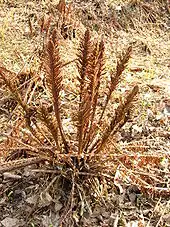Matteuccia
Matteuccia is a genus of ferns with one species: Matteuccia struthiopteris (common names ostrich fern,[4] fiddlehead fern, or shuttlecock fern). The species epithet struthiopteris comes from Ancient Greek words στρουθίων (strouthíōn) "ostrich" and πτερίς (pterís) "fern".
| Matteuccia | |
|---|---|
 | |
| Sterile fronds in summer | |
| Scientific classification | |
| Kingdom: | Plantae |
| Clade: | Tracheophytes |
| Class: | Polypodiopsida |
| Order: | Polypodiales |
| Suborder: | Aspleniineae |
| Family: | Onocleaceae |
| Genus: | Matteuccia Tod. |
| Species: | M. struthiopteris |
| Binomial name | |
| Matteuccia struthiopteris | |
| Synonyms[1] | |
|
List of synonyms
| |
Description
The fronds are dimorphic, with the deciduous green sterile fronds being almost vertical, 100–170 cm (39–67 in) tall[5] and 20–35 cm (7.9–13.8 in) broad, long-tapering to the base but short-tapering to the tip,[5] so that they resemble ostrich plumes, hence the name. The fertile fronds are shorter, 40–65 cm (16–26 in) long, brown when ripe,[5] with highly modified and constricted leaf tissue curled over the sporangia; they develop in autumn, persist erect over the winter and release the spores in early spring. Along with Dryopteris goldieana, it is one of the largest species of fern in eastern North America.
Classification
Matteuccia struthiopteris is the only species in the genus Matteuccia. Some sources include two Asian species, M. orientalis and M. intermedia, but molecular data shows that M. struthiopteris is more closely related to Onocleopsis and Onoclea (sensitive fern) than it is to M. orientalis and M. intermedia, and so the latter should be moved to a genus Pentarhizidium which contains those two species.[6] Formerly classified as a member of the Dryopteridaceae, Matteuccia has been reassigned to the new much smaller family Onocleaceae.
Distribution
It is a crown-forming, colony-forming plant, occurring in temperate regions of the Northern Hemisphere in central and northern Europe,[7] northern Asia,[8] and northern North America.[9] It grows from a completely vertical crown, favoring riverbanks and sandbars, but sends out lateral stolons to form new crowns. It can thus form dense colonies resistant to destruction by floodwaters.
Cultivation and uses


The ostrich fern is a popular ornamental plant in gardens. It has gained the Royal Horticultural Society's Award of Garden Merit.[10][11] While choosing a place of planting it should be taken into account that this fern is very expansive and its leaves often lose their beauty throughout the summer, especially if not protected from wind and hail.
The tightly wound immature fronds, called fiddleheads, are also used as a cooked vegetable,[12] and are considered a delicacy mainly in rural areas of northeastern North America. It is considered inadvisable to eat uncooked fiddleheads.[12] Brown "scales" are inedible and should be scraped or rinsed off.[5]
The sprouts are also picked all over Japan, ("kogomi" in Japanese)[13] where they are a delicacy.
Matteuccia species are used as food plants by the larvae of some Lepidoptera species including Sthenopis pretiosus.
References
- "Matteuccia struthiopteris". Tropicos. Missouri Botanical Gardens – via The Plant List.
- Johnson, David M. (1993). "Matteuccia struthiopteris var. pensylvanica". In Flora of North America Editorial Committee (ed.). Flora of North America North of Mexico (FNA). 2. New York and Oxford – via eFloras.org, Missouri Botanical Garden, St. Louis, MO & Harvard University Herbaria, Cambridge, MA.
- Elias, Thomas; Dykeman, Peter (1982). Edible Wild Plants. New York, NY: Sterling Publishing Co., Inc. p. 58. ISBN 978-1-4027-6715-9.
- "BSBI List 2007". Botanical Society of Britain and Ireland. Archived from the original (xls) on 23 October 2014. Retrieved 17 October 2014.
- Elias, Thomas S.; Dykeman, Peter A. (2009) [1982]. Edible Wild Plants: A North American Field Guide to Over 200 Natural Foods. New York: Sterling. p. 58. ISBN 978-1-4027-6715-9. OCLC 244766414.
- Gastony, GJ; Ungerer, MC (1997). "Molecular systematics and a revised taxonomy of the onocleoid ferns (Dryopteridaceae: Onocleeae)". American Journal of Botany. 84 (6): 840–849. doi:10.2307/2445820. JSTOR 2445820. PMID 21708636.
- Altervista Flora Italiana, Felce penna di struzzo, Matteuccia struthiopteris (L.) Tod.
- Xing, Fuwu; Wang, Faguo; Kato, Masahiro. "Matteuccia struthiopteris". Flora of China. 2 – via eFloras.org, Missouri Botanical Garden, St. Louis, MO & Harvard University Herbaria, Cambridge, MA.
- "Matteuccia struthiopteris". State-level distribution map from the North American Plant Atlas (NAPA). Biota of North America Program (BONAP). 2014.
- "RHS Plant Selector - Matteuccia struthiopteris". Retrieved 24 May 2013.
- "AGM Plants - Ornamental" (PDF). Royal Horticultural Society. July 2017. p. 65. Retrieved 4 April 2018.
- "Bulletin #4198, Facts on Fiddleheads - Cooperative Extension Publications - University of Maine Cooperative Extension". Cooperative Extension Publications. Retrieved 2 January 2021.
- LaPointe, Rick (21 April 2002). "Let us go fiddlehead foragin', but carefully". The Japan Times. Tokyo. Archived from the original on 20 March 2011. Retrieved 13 March 2011.
Sources
| Wikimedia Commons has media related to Matteuccia struthiopteris. |
- Hyde, H. A., Wade, A. E., & Harrison, S. G. (1978). Welsh Ferns. National Museum of Wales.
